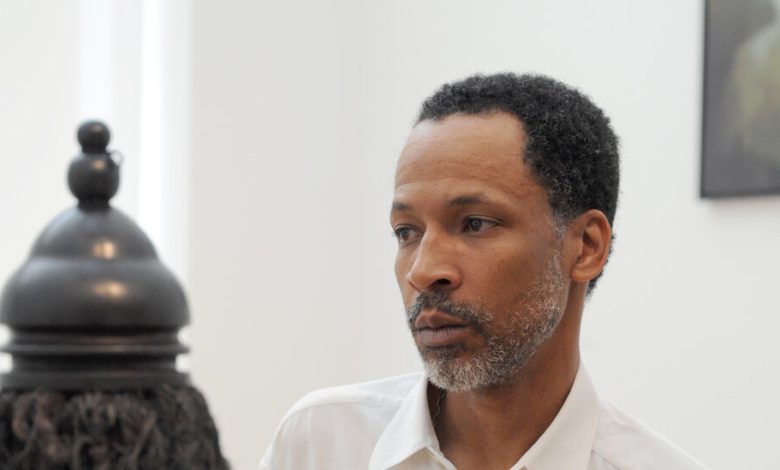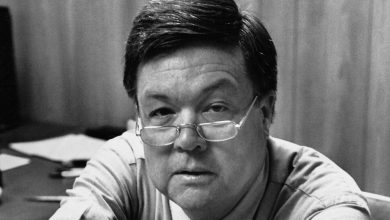Radcliffe Bailey, Artist Who Explored Black Migration, Dies at 54


The artist Radcliffe Bailey at the High Museum in Atlanta in 2011, when it presented an exhibition of his work.Credit…Erik S. Lesser for The New York Times
Radcliffe Bailey, a Georgia-based artist whose collage paintings and sculptural assemblages incorporated family tintypes, African figurines, disassembled piano keys and other objects in an exploration of both his personal history and the broader sorrows and joys of the Black experience, died on Nov. 14 at his home in Atlanta. He was 54.
The cause was glioblastoma multiforme, a type of brain cancer, his brother, Roy, said.
Over the course of his career, Mr. Bailey continually drew inspiration from Atlanta, where he had lived since childhood — from its tangled legacy of slavery and Civil War bloodshed, but also from its rich history of Black culture and achievement.
His work became a common sight around the city. Among his public works is the mural “Saints,” a 40-foot-long collage from 1996 blending exuberant blocks of color with old photos of dead relatives, text referencing Black culture and African symbols, which is on permanent display at Hartsfield-Jackson Atlanta International Airport.
History was ever-present for Mr. Bailey. He lived in a gallerylike modernist house on seven wooded acres about eight miles from downtown Atlanta, near the site of the Battle of Utoy Creek, where Maj. Gen. William Tecumseh Sherman’s Union forces squared off against Confederate troops during his scorched-earth campaign through Georgia in 1864.
“Atlanta has this interesting past that makes you want to dig deeper and understand what was once there, even though it may be covered,” Mr. Bailey said in interview with The New York Times after the exhibition “Radcliffe Bailey: Memory as Medicine” opened at the High Museum of Art in Atlanta in 2011. “Sherman burned down the city. They say when you want to get rid of something, you burn it, but you don’t really get rid of it.”
Mr. Bailey often conjured his own past in his work by incorporating objects with personal meaning, like vinyl records, red Georgia clay and old family tintypes — photographic images on thin metal sheets — from a collection of some 400 his grandmother had given him, in pursuit of a personal and cultural catharsis. “I’ve always felt,” he once said, “like the only way I can heal myself is to go back through my memory, learn from memory.”
As Jack Shainman, a New York gallerist who represents Mr. Bailey’s work, put it in a phone interview, “The story he tells, the poetry — it’s not a ‘me’ thing, it’s a ‘we’ thing.”
The 2011 High Museum exhibition featured the large-scale installation “Windward Coast,” a sea of wooden keys salvaged from hundreds of broken-down old pianos, with a bust of a Black head and a ship seemingly bobbing among the waves — all of which suggested not just the cruelty of the slave trade but also something beyond that.
“I think about all the music that was probably played on those keys,” Mr. Bailey told The Times. “An ocean is something that divides people. Music is something that connects people. Duke Ellington or Thelonious Monk — it’s a different sound that takes you somewhere else. It’s also about being at peace.”
The African diaspora, whether in bondage in centuries past or by choice during the northern migration following the Civil War, was a common subject of his work.
This year he exhibited “Upwards” (2018), a roughly 20-square-foot rumination on such themes, at Art Basel in Switzerland. That piece, equal parts painting and sculpture, consists of a patched shipping tarp overlaid with steel railroad tracks, with a dot of neon light near the top representing the North Star.
The tracks contain a cross pattern, a reference to the African dikenga, also known as the congo cosmogram, a chart that symbolizes the cycle of life from birth to the realm of the ancestors. “I feel like we’ve always been moving back and forth,” he said in a 2021 interview with The Brooklyn Rail. “You know, referring to migration, we’ve always moved from north to south to east to west. We’ve crossed the ocean.”
Though Mr. Bailey himself never migrated from his adopted home, Georgia, after moving there as a child, he chafed at being pigeonholed as a Southern artist, or for that matter as a Black artist. “I don’t want to be the ‘other,’” he said in a 2013 interview with Bomb magazine.
“I see myself as making work that is universal in many ways,” he added. “First and foremost people say, ‘You’re this, you’re that,’ but I’m human. These names and categories change across time, and I want to make work that’s timeless.”
Radcliffe Orville Bailey Jr. was born on Nov. 25, 1968, in Bridgeton, N.J., the elder of two sons of a railroad engineer father and a schoolteacher mother, Brenda (Coles) Bailey.
His father’s side of the family had originally settled in New Jersey while fleeing oppression in the South after the Civil War. That family migration saga, Mr. Bailey said in a 2020 video interview, would later inform his work.
In addition to his brother, Mr. Bailey issurvived by his wife, Leslie (Parks) Bailey; a daughter, Olivia Bailey; and a son, Radcliffe Coles Bailey, known as Coles.
When Mr. Bailey was 4 years old, his family was on their way to Florida on a road trip when they stopped at Paschal’s, an Atlanta soul food restaurant that was popular with civil rights leaders, where they met the Rev. Lucius M. Tobin, a professor of religion at Morehouse College. Mr. Tobin’s family led the Baileys on a historical tour of the city, and the Baileys, who were already considering a move to either the South or the West, settled in Atlanta soon after.
Growing up in the same neighborhood as the Atlanta Braves star and future Baseball Hall of Famer Henry Aaron, Mr. Bailey aspired to play baseball professionally himself. He eventually made it to the semipro level as a catcher before turning his focus to another lifelong passion: art.
He studied sculpture at the Atlanta College of Art and graduated with a bachelor’s degree in fine art in 1992. His early work after college was “somewhat minimal,” he told Art in America in 2021. “I only began working with photographs for personal reasons that had to do with my family, specifically the loss of family members.”
“I also felt like I was dealing with two different worlds,” he added, “one world of things that were tangible, and another world that was abstract and surreal. I always thought the surreal was real to Black people.”




